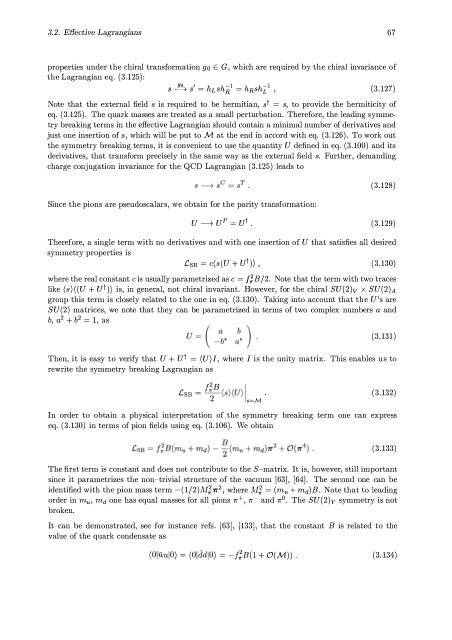The Nucleon-Nucleon Interaction in a Chiral Effective Field Theory
The Nucleon-Nucleon Interaction in a Chiral Effective Field Theory
The Nucleon-Nucleon Interaction in a Chiral Effective Field Theory
Create successful ePaper yourself
Turn your PDF publications into a flip-book with our unique Google optimized e-Paper software.
3.2. <strong>Effective</strong> Lagrangians 67<br />
properties under the chiral transformation 90 E G, which are required by the chiral <strong>in</strong>variance of<br />
the Lagrangian eq. (3.125):<br />
90 I h h-1 h h-1 S -"-+ S = L S R = RS L , ( 3.12 7)<br />
Note that the external field S is required to be hermitian, st = s, to provide the hermiticity of<br />
eq. (3.125). <strong>The</strong> quark masses are treated as a small perturbation. <strong>The</strong>refore, the lead<strong>in</strong>g symmetry<br />
break<strong>in</strong>g terms <strong>in</strong> the effective Lagrangian should conta<strong>in</strong> a m<strong>in</strong>imal number of derivatives and<br />
just one <strong>in</strong>sertion of s, which will be put to M at the end <strong>in</strong> accord with eq. (3.126). To work out<br />
the symmetry break<strong>in</strong>g terms, it is convenient to use the quantity U def<strong>in</strong>ed <strong>in</strong> eq. (3.100) and its<br />
derivatives, that transform precisely <strong>in</strong> the same way as the external field s. Furt her , demand<strong>in</strong>g<br />
charge conjugation <strong>in</strong>variance for the QCD Lagrangian (3.125) leads to<br />
S<strong>in</strong>ce the pions are pseudoscalars, we obta<strong>in</strong> for the parity transformation:<br />
(3.128)<br />
U ----+ U P = ut . (3.129)<br />
<strong>The</strong>refore, a s<strong>in</strong>gle term with no derivatives and with one <strong>in</strong>sertion of U that satisfies all desired<br />
symmetry properties is<br />
LSB = c(s(U + ut)) , (3.130)<br />
where the real constant cis usually parametrized as c = {;B /2. Note that the term with two traces<br />
like (s)((U + ut)) is, <strong>in</strong> general, not chiral <strong>in</strong>variant. However, for the chiral SU(2)v x SU(2)A<br />
group this term is closely related to the one <strong>in</strong> eq. (3.130). Tak<strong>in</strong>g <strong>in</strong>to account that the U's are<br />
SU(2) matrices, we note that they can be parametrized <strong>in</strong> terms of two complex numbers a and<br />
b, a 2 + b 2 = 1, as<br />
(3.131)<br />
<strong>The</strong>n, it is easy to verify that U + ut = (U)I, where I is the unity matrix. This enables us to<br />
rewrite the symmetry break<strong>in</strong>g Lagrangian as<br />
j2B<br />
LSB = _7r_ (s)(U) .<br />
2 s=M<br />
I<br />
(3.132)<br />
In order to obta<strong>in</strong> a physical <strong>in</strong>terpretation of the symmetry break<strong>in</strong>g term one can express<br />
eq. (3.130) <strong>in</strong> terms of pion fields us<strong>in</strong>g eq. (3.106). We obta<strong>in</strong><br />
(3.133)<br />
<strong>The</strong> first term is constant and does not contribute to the S-matrix. It is, however, still important<br />
s<strong>in</strong>ce it parametrizes the non-trivial structure of the vacuum [63], [64]. <strong>The</strong> second one can be<br />
identified with the pion mass term -(1/2)M;7r2 , where M; = (mu + md)B. Note that to lead<strong>in</strong>g<br />
order <strong>in</strong> mu, md one has equal masses for all pions 7f +, 7f - and 7f0. <strong>The</strong> SU (2) v symmetry is not<br />
broken.<br />
It can be demonstrated, see for <strong>in</strong>stance refs. [63], [133], that the constant B is related to the<br />
value of the quark condensate as<br />
(OluuIO) = (OlddIO) = -f;B(l + O(M)) . (3.134)












